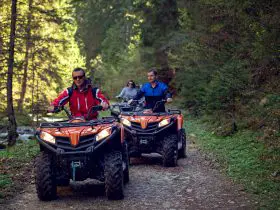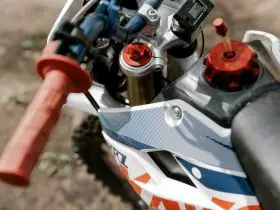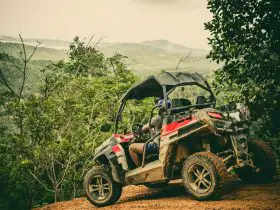UTVs, or utility terrain vehicles, are incredibly versatile. Many property owners use them to make managing farmland or large tracts of land much easier. Yet others use them purely for recreation, as they allow for more passengers and more gear-hauling potential than a standard ATV.
Regardless of how you plan to use your utility terrain vehicle, however, you need to ensure it’s legal before you even begin driving it. As with a car or recreational vehicle, you need to register it with the state.
And just like a car, you’ll get a registration sticker that you need to affix to your vehicle. Wondering where to place the registration sticker UTV owners are given once their vehicles are successfully registered?
Keep reading to learn why you need to register your UTV, how to get it registered, and where to position the registration sticker upon completion.
Table of Contents
Types of UTV Registration
UTVs are used for different purposes. Some use them for farming, others for recreation or personal property management. Still, others are used by the government or municipal entities.
In the past, the use of various types of ORVs was unregulated. But after realizing that countless accidents were leading to fatalities and injuries, especially among children, many states have adopted stricter policies regarding ORV use.
This includes minimum age requirements, registration and licensing requirements, and other state-specific laws regarding UTV use.
As a result, the type of registration you receive dictates what you are allowed to do and not with your UTV. Because they are small, off-road vehicles, they typically aren’t allowed on regular roads. This leaves you with only certain rural roads, public property, or private property to use your UTV on.
A public use registration will let you operate your UTV on any public land open to UTV use. This might mean UTV/ATV trails or rural roads designated to be shared with UTVs. This type of registration will also let you operate your UTV on private property, whether it’s your own or property you have permission to drive on.
A private registration will allow you to use your UTV on your own land or that of an immediate family member, but not on public use areas. This is generally adequate for those hauling lumber or using a UTV to clear snow.
And an agricultural registration will let you transport supplies and goods from one agricultural property to another.
Registration for UTV; What You Need to Do
When you buy a UTV, you’ll be issued an off-road title. This is important because an off-road title limits your use of your UTV. You cannot ride it on public roads where normal vehicle traffic operates, as your UTV does not meet the safety standards of these roads.
In some states, there are certain UTVs that can be modified with the necessary safety equipment to meet on-road standards and can be titled as such. For example, in the state of Michigan, you can retitle vehicles such as the John Deere Gator or the Polaris Ranger to operate on public roads with the addition of equipment such as proper tires and headlights, among others.
To register your UTV, you can either visit your state’s DNR, SOS, or DMV website or visit a local branch to complete your registration. You’ll need your vehicle’s VIN, and you’ll need to complete a basic application form. Registration fees vary depending on your state and the type of registration you choose.
Official registration stickers will be mailed to your home address. Since this can take a couple of weeks, you should be issued a temporary operating receipt that will allow you to legally drive your UTV without your registration sticker.
Keep this receipt on you at all times when operating your UTV.
Registration Sticker UTV; Where to Place It
So, where does the registration sticker go on a UTV? You should receive two stickers. They are to be placed directly on your UTV, one on either side and in front of the driver.
This makes it easy for law enforcement officers to see your current registration without having to stop you.
In addition to the two front stickers, if you plan to use your UTV on public trails and forest roads, you’ll also need a license plate on the rear of the vehicle. Depending on your state, you may be allowed to make one yourself, following your state’s legibility guidelines, or you can purchase one.
The license plate needs to clearly display your UTVs registration number. It’s the same number on your registration sticker and registration card.
The license plate needs to be visible and legible at all times. This can be difficult when riding in rough, muddy conditions. Make sure to clear your license plate regularly to avoid any run-ins with law enforcement.
State-Specific UTV Requirements
Every state has different laws and registration requirements regarding UTV use. Be sure to research your specific state’s rules so you can drive legally. Also, if you plan to bring your UTV to another state, to use on private or public land, know the laws. You may need a temporary registration in that state.
In Michigan, you don’t need to register your UTV if you plan to use it solely on private land. If you want to operate on public trails, you’re going to need a trail permit. If you want to use UTV-specific county roads, or frozen lakes and streams, you’ll need an ORV license.
In California, when registering your UTV, you’ll receive two different decals. One of them means that you can operate on public lands and trails. The other decal you receive determine’s your UTVs emission status. A green decal means you’ve passed, and your UTV meets state emission requirements.
A red decal, on the other hand, means that your vehicle fails to meet state emissions requirements. This prohibits this particular vehicle from operating during the riding seasons. The designation is permanent, and you cannot modify your UTV to meet the standards.
Insuring Your UTV
Aside from registering your UTV, is there anything else you should do before you start driving? Insuring your UTV might not be required, but it’s a great idea.
Obviously, you want insurance on the vehicle itself since UTVs aren’t cheap. If you crash into something, or if a tree falls on it, you want to be covered.
But you especially want insurance if you are riding on public trails or roads. If you cause damage to someone else’s property, or if you injure someone, you can be held liable. Having the right coverage in place can protect you in these circumstances.
Where to Operate Your UTV
So your UTV is now registered and insured, and you’re safe to start operating your new vehicle. But where can you ride?
Most people who own a UTV have their own property they can drive on. If not, you can still make the most of your UTV.
Many states have designated ORV trail systems that are built and maintained specifically for off-road vehicles. Some are multi-use trails shared with other users, such as mountain bikes. Know what to expect on every trail you ride ahead of time.
More often than not, however, these are built for your off-roading pleasure.
Michigan boasts over 3,000 miles of ORV trails. These trails wind through national forests, state parks, state forests, and ORV-specific parks. You can also operate your UTV on many service roads in the national forest system.
If you plan to travel with your UTV, states in the west, such as Utah, Colorado, Wyoming, and Montana, have massive networks of trails to take your UTV on. Just be sure to study up on riding seasons and state registration requirements.
Why You Should Get a UTV
UTVs are extremely practical. If you have a large property and find yourself having to walk across it all the time, a UTV is the solution you are looking for.
Whether you use the property for hunting, farming, or anything in between, having a UTV will make it much easier to keep tabs on your entire property.
They are especially helpful if you have to haul tools and debris around. Need to trim trees across the property or cut up a log that fell? UTVs can carry and pull a ton of weight.
And, of course, driving a UTV is fun. They offer you a great way to experience all of the incredible trails that your state has to offer. You can cover far more ground than if you were hiking and biking, drive much faster, and scramble up rocky mountainsides or sprawling sand dunes.
It sounds like the perfect way to spend the weekend. Whether for functionality or recreation, getting a UTV is a smart move. Especially since getting it registered, and legal is cheap and easy.
Get Registered and Get Out There
Now that you know where to put the registration sticker UTV owners receive in the mail, you can get your new vehicle up and running legally in no time. The most important thing to consider is choosing the right type of registration and placing the sticker on a permanent part of your vehicle’s frame in front of the driver.
Do yourself a favor and make it as easy as possible to see, or law enforcement isn’t going to be very happy with you.
Looking to get your own UTV? Check out our guide to choosing the best sport, UTV.










